Marketing Strategy for Huawei: Analysis, Competitive Advantage, and Recommendations
Huawei's marketing strategy and analysis of external and internal factors affecting the business.
34 Pages5168 Words52 Views
Added on 2023-01-16
About This Document
This paper analyzes the marketing strategy of Huawei, including the external and internal analysis, competitive advantage, and recommendations for entering the global market. It also discusses the company's strengths, weaknesses, opportunities, and threats. The study recommends strategies based on Huawei's marketing mix.
Marketing Strategy for Huawei: Analysis, Competitive Advantage, and Recommendations
Huawei's marketing strategy and analysis of external and internal factors affecting the business.
Added on 2023-01-16
ShareRelated Documents
Running head: MARKETING STRATEGY
Abstract
Huawei is the one of the global leading company in the telecom sectors along with the great
range of products that includes mobile phones, tablets, wearable, broad band devices and the
home devices. This is the manufacturer of the telecom equipment and the Chinese
multifunctional telecom company that is headquartered in Shenzhen, China. This first part will
be depend upon the external analysis and the internal analysis of the market. This will also
involve the external factors and the internal factors that creates risks for the business. In the first
part of the study, this will include the business competitive advantages and the present marketing
strategy of the business. In the second part of the paper the business will involve segmentation,
market and the business position in the market. This study also recommends the business
strategies of entering the global business market and these strategies are mostly based upon
Huawei’s marketing mix.
Abstract
Huawei is the one of the global leading company in the telecom sectors along with the great
range of products that includes mobile phones, tablets, wearable, broad band devices and the
home devices. This is the manufacturer of the telecom equipment and the Chinese
multifunctional telecom company that is headquartered in Shenzhen, China. This first part will
be depend upon the external analysis and the internal analysis of the market. This will also
involve the external factors and the internal factors that creates risks for the business. In the first
part of the study, this will include the business competitive advantages and the present marketing
strategy of the business. In the second part of the paper the business will involve segmentation,
market and the business position in the market. This study also recommends the business
strategies of entering the global business market and these strategies are mostly based upon
Huawei’s marketing mix.
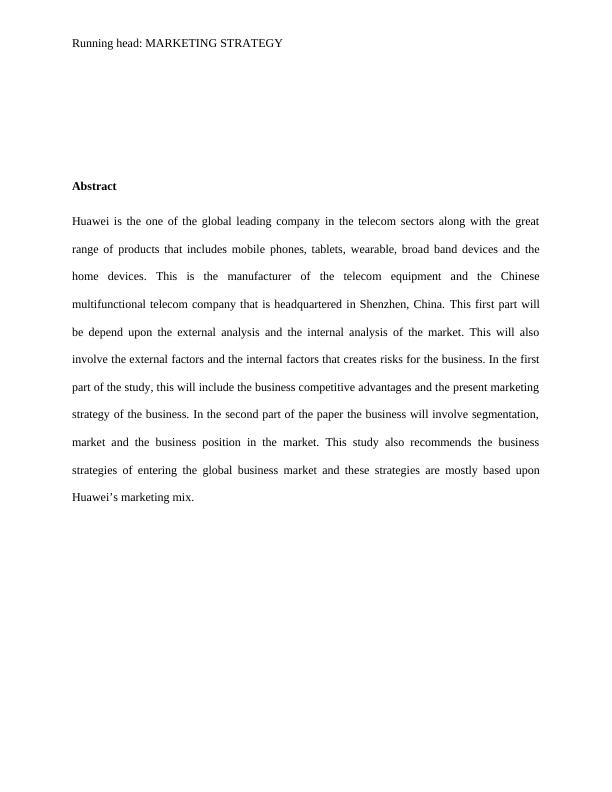
1MARKETING STRATEGY
Table of Contents
Part 1...............................................................................................................................................4
1.0 Introduction..............................................................................................................................4
2.0 Situation analysis.....................................................................................................................4
2.1 Political condition................................................................................................................5
2.2 Economic condition.............................................................................................................6
2.3 Socio-Cultural condition.....................................................................................................7
2.4 Technological condition.......................................................................................................8
2.5 Environmental condition...................................................................................................10
2.6 Legal condition...................................................................................................................11
2.7 Strength..............................................................................................................................12
2.8 Weakness............................................................................................................................12
2.9 Opportunity........................................................................................................................12
2.10 Threats..............................................................................................................................13
3.0 Competitive advantage (USP)...............................................................................................13
4.0 Perceptual map......................................................................................................................13
5.0 Comparative analysis............................................................................................................14
5.1 Two competitor: apple and Lenovo.................................................................................14
5.2 Evaluation of current marketing strategy...........................................................................16
6.0 Survey.....................................................................................................................................18
Part 2.............................................................................................................................................24
1.1 Segmentation targeting and positioning (STP)...................................................................24
1.2 Time Space Chart of Target customers...............................................................................25
Table of Contents
Part 1...............................................................................................................................................4
1.0 Introduction..............................................................................................................................4
2.0 Situation analysis.....................................................................................................................4
2.1 Political condition................................................................................................................5
2.2 Economic condition.............................................................................................................6
2.3 Socio-Cultural condition.....................................................................................................7
2.4 Technological condition.......................................................................................................8
2.5 Environmental condition...................................................................................................10
2.6 Legal condition...................................................................................................................11
2.7 Strength..............................................................................................................................12
2.8 Weakness............................................................................................................................12
2.9 Opportunity........................................................................................................................12
2.10 Threats..............................................................................................................................13
3.0 Competitive advantage (USP)...............................................................................................13
4.0 Perceptual map......................................................................................................................13
5.0 Comparative analysis............................................................................................................14
5.1 Two competitor: apple and Lenovo.................................................................................14
5.2 Evaluation of current marketing strategy...........................................................................16
6.0 Survey.....................................................................................................................................18
Part 2.............................................................................................................................................24
1.1 Segmentation targeting and positioning (STP)...................................................................24
1.2 Time Space Chart of Target customers...............................................................................25

2MARKETING STRATEGY
2.3 Recommended objectives and goals (SMART)...................................................................27
Recommended marketing strategies based on the application of the marketing mix to your
chosen branded supermarket chain...........................................................................................28
1.3 Marketing Mix...................................................................................................................28
1.4 Conclusion..............................................................................................................................29
1.5 Bibliography...........................................................................................................................31
2.3 Recommended objectives and goals (SMART)...................................................................27
Recommended marketing strategies based on the application of the marketing mix to your
chosen branded supermarket chain...........................................................................................28
1.3 Marketing Mix...................................................................................................................28
1.4 Conclusion..............................................................................................................................29
1.5 Bibliography...........................................................................................................................31
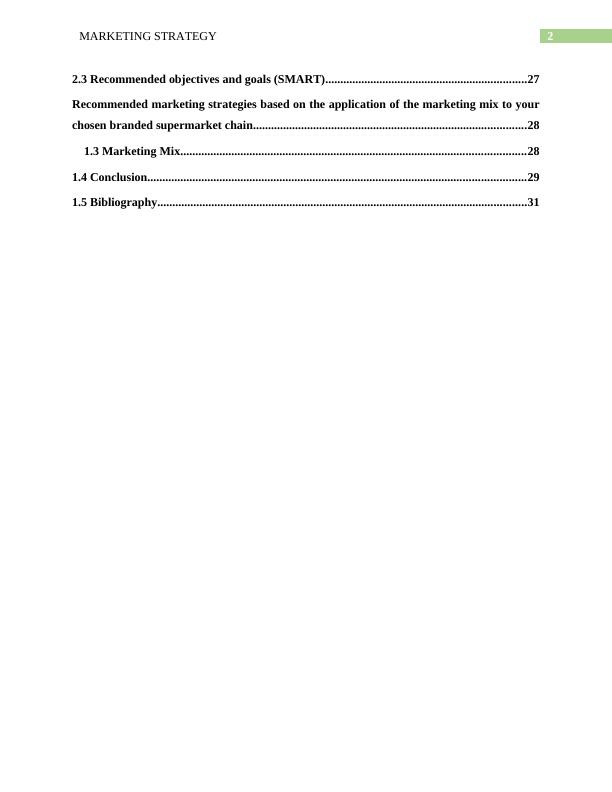
3MARKETING STRATEGY
Part 1
1.0 Introduction
Huawei targets the lower income segments as the production cost of the products are low
the company is able to provide the quality products in less price thereby attracting the people of
low income segments. Huawei has not been able to compete in the global business market as
there is tough competition with the leading brands although it is one of the largest global telecom
company (Islam 2018). The first part of the paper will analyze the situation analysis of the
company by describing the political, economic, technical, legal and environmental condition.
This also involves the strength, weakness, opportunities and threats of the business. This study
will involve the external and the internal market analysis for understanding the external and
internal benefits and the risks, the organization is facing. The study will also describe the
competitive advantage for the business and the current marketing strategy followed by the
business. The second part of the paper will involve the segmentation, target and the position of
the organization in the business market. This paper recommends the strategies for the business
for competing in the business market. The recommendation of strategies will be based upon the
marketing mix of the organization.
2.0 Situation analysis
The PESTEL investigation is considered as the system that are utilized by the advertisers
for breaking down and checking the miniaturized scale ecological variables which makes
extraordinary effect on the association. This decides the dangers and shortcoming of the
association.
Part 1
1.0 Introduction
Huawei targets the lower income segments as the production cost of the products are low
the company is able to provide the quality products in less price thereby attracting the people of
low income segments. Huawei has not been able to compete in the global business market as
there is tough competition with the leading brands although it is one of the largest global telecom
company (Islam 2018). The first part of the paper will analyze the situation analysis of the
company by describing the political, economic, technical, legal and environmental condition.
This also involves the strength, weakness, opportunities and threats of the business. This study
will involve the external and the internal market analysis for understanding the external and
internal benefits and the risks, the organization is facing. The study will also describe the
competitive advantage for the business and the current marketing strategy followed by the
business. The second part of the paper will involve the segmentation, target and the position of
the organization in the business market. This paper recommends the strategies for the business
for competing in the business market. The recommendation of strategies will be based upon the
marketing mix of the organization.
2.0 Situation analysis
The PESTEL investigation is considered as the system that are utilized by the advertisers
for breaking down and checking the miniaturized scale ecological variables which makes
extraordinary effect on the association. This decides the dangers and shortcoming of the
association.
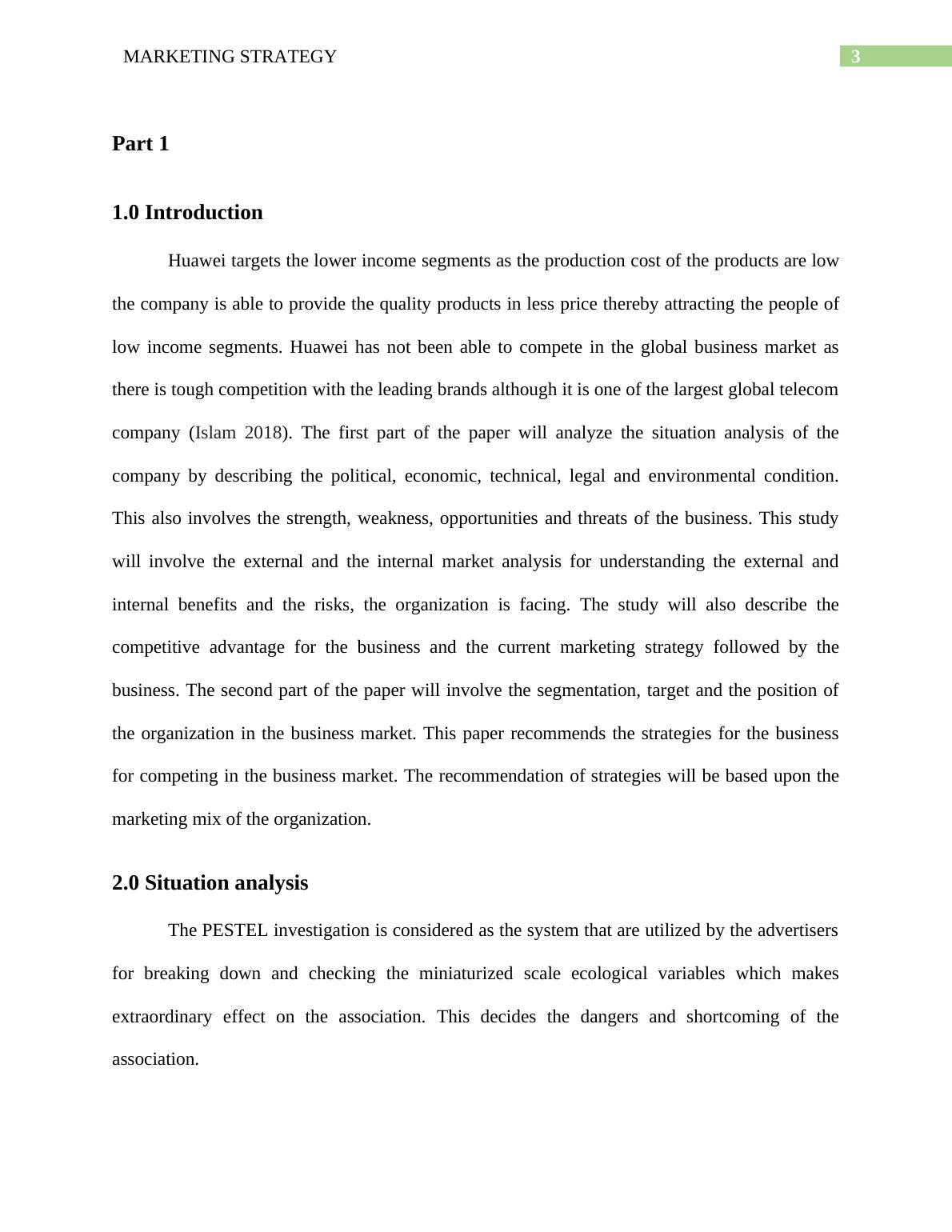
4MARKETING STRATEGY
2.1 Political condition
The Chinese political environment plays a great role on the Huawei’s largest business
market. The governing party has a great influence on the economic environment of the country.
Thereby any incidence which effects the politics of China and has heavy impact on the profit
margin of Huawei. During the political promotions and the meetings of national Congress, the
stock prices of most of the Chinese business firm fall (Sanga 2017). The global profitability of
the business is subjected to the political climate of the respective country. On the other hand this
is found out that the international and the local politics could affect the business operations of
Huawei in the positive manner. The Chinese governments also supports the telecommunication
sectors by providing the sufficient training for the engineering students that increases the
effectiveness of the domestic labor force and this makes the domestic labor force highly
competitive. The loans and incentives for promoting the local manufacturers gives the local
business an edge for the foreign counterparts (Tarannum and Hassan 2016).
2.1 Political condition
The Chinese political environment plays a great role on the Huawei’s largest business
market. The governing party has a great influence on the economic environment of the country.
Thereby any incidence which effects the politics of China and has heavy impact on the profit
margin of Huawei. During the political promotions and the meetings of national Congress, the
stock prices of most of the Chinese business firm fall (Sanga 2017). The global profitability of
the business is subjected to the political climate of the respective country. On the other hand this
is found out that the international and the local politics could affect the business operations of
Huawei in the positive manner. The Chinese governments also supports the telecommunication
sectors by providing the sufficient training for the engineering students that increases the
effectiveness of the domestic labor force and this makes the domestic labor force highly
competitive. The loans and incentives for promoting the local manufacturers gives the local
business an edge for the foreign counterparts (Tarannum and Hassan 2016).

5MARKETING STRATEGY
Rank of China among 203 counties
Source (Market Research Blog, 2019)
2.2 Economic condition
The economic risks that the organization faces are that Apple becoming the major
competitors of Huawei have the vast resource reservoirs that Huawei struggles to increase the
capital, this affects the economic conditions of Huawei. Moreover the value added tax in the
telecommunication sectors increases the business operation cost and this also diminishes the
profitability margins of the business. But as the domestic economy is growing fast, this also
increases the disposable income and also the demand of the luxury products like the quality
mobile phones (Simões 2016).
Rank of China among 203 counties
Source (Market Research Blog, 2019)
2.2 Economic condition
The economic risks that the organization faces are that Apple becoming the major
competitors of Huawei have the vast resource reservoirs that Huawei struggles to increase the
capital, this affects the economic conditions of Huawei. Moreover the value added tax in the
telecommunication sectors increases the business operation cost and this also diminishes the
profitability margins of the business. But as the domestic economy is growing fast, this also
increases the disposable income and also the demand of the luxury products like the quality
mobile phones (Simões 2016).
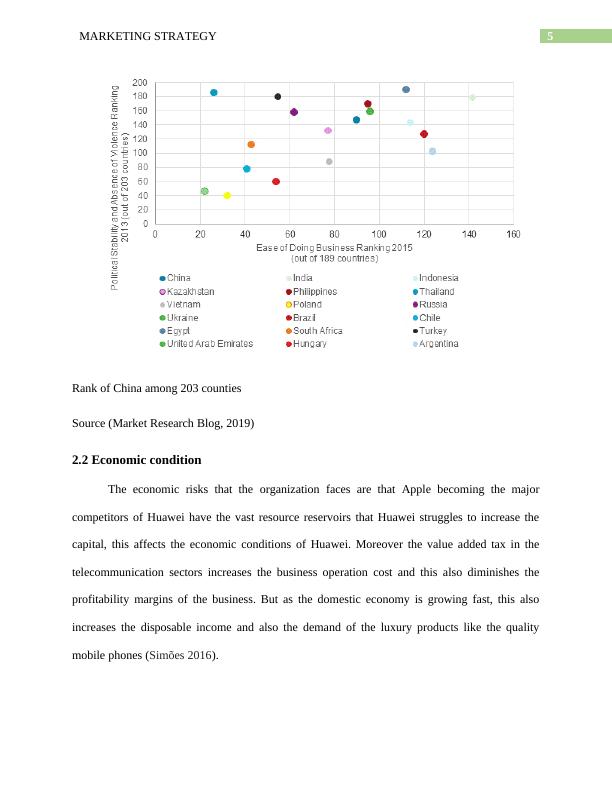
6MARKETING STRATEGY
China economy
Source: Heritage.org. (2019)
2.3 Socio-Cultural condition
The China markets are developing day by day as the nation is for the most part populated
with more than 1.3 billion individuals. The high populace likewise gives a wide business market
to the Huawei items and furthermore close to these things the vast populace builds up the
China economy
Source: Heritage.org. (2019)
2.3 Socio-Cultural condition
The China markets are developing day by day as the nation is for the most part populated
with more than 1.3 billion individuals. The high populace likewise gives a wide business market
to the Huawei items and furthermore close to these things the vast populace builds up the
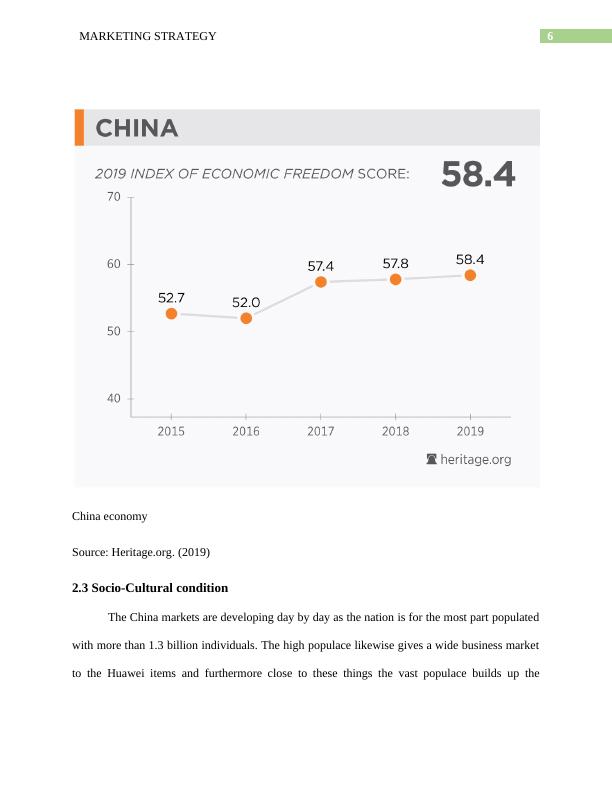
7MARKETING STRATEGY
precarious requests for the items as the quantity of purchasers continues expanding, this makes
beneficial outcomes on the business (Moutinho and Phillips 2018).
Hofstede chart of China
Source: (Hofstede Insights, 2019)
2.4 Technological condition
The modernization rate in China is becoming high and everybody is becoming digital. As
the people wants to remain connected with the digital world this leads to better sales. The
Chinese Government ensures that the innovations especially in ICT will be providing high-
precarious requests for the items as the quantity of purchasers continues expanding, this makes
beneficial outcomes on the business (Moutinho and Phillips 2018).
Hofstede chart of China
Source: (Hofstede Insights, 2019)
2.4 Technological condition
The modernization rate in China is becoming high and everybody is becoming digital. As
the people wants to remain connected with the digital world this leads to better sales. The
Chinese Government ensures that the innovations especially in ICT will be providing high-
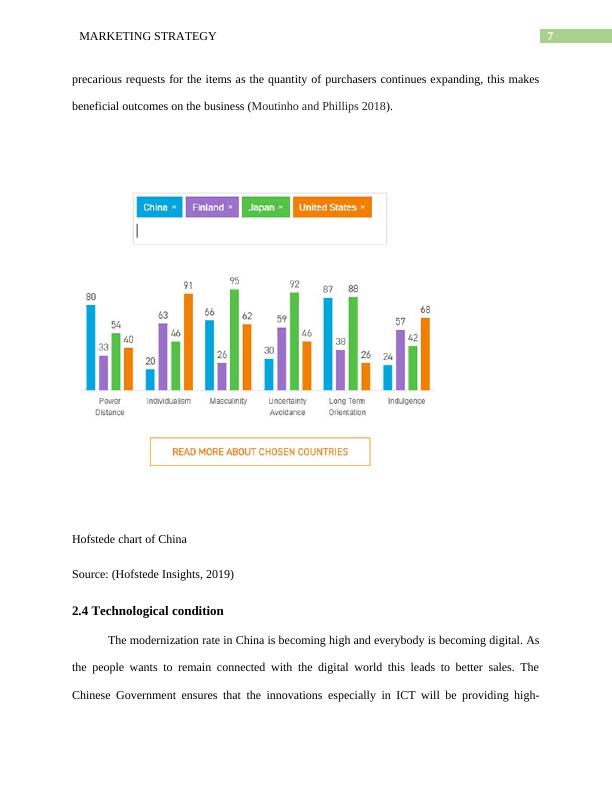
End of preview
Want to access all the pages? Upload your documents or become a member.
Related Documents
Marketing Strategy for Huaweilg...
|29
|5097
|62
Marketing Strategy for Huaweilg...
|28
|4392
|116
Marketing Strategy for Huawei: Market Analysis and Segmentationlg...
|23
|3708
|438
Marketing Planning Assignment : Huaweilg...
|8
|1492
|282
Global and Transnational Businesslg...
|31
|6076
|255
Marketing Strategylg...
|18
|4188
|334
